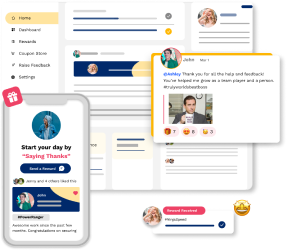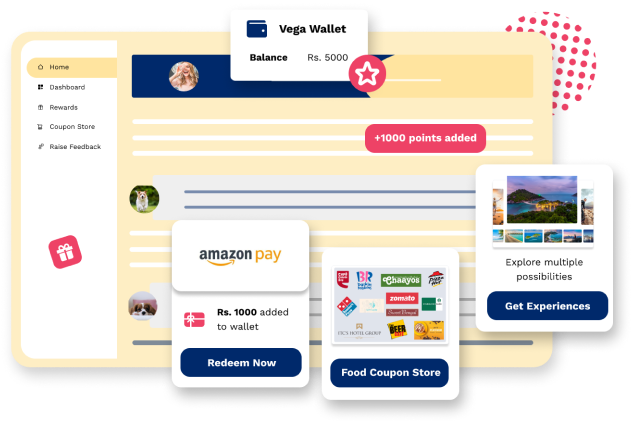Introduction
"In a world where money is no longer the primary motivating factor for employees, focusing on the employee experience is the most promising competitive advantage that organisations can create." - Jacob Morgan
According to a 2021 Willis Towers Watson global survey, 92% of employers said enhancing employee experience is a crucial priority for their corporations for the next three years. Why?
Every day, the battle to capture the hearts and minds of employees unfolds through their unique workplace encounters. Just as organizations strive to secure customer loyalty, preferences, and patronage, they are now shifting their focus toward cultivating environments that foster an engaged and productive workforce. With a deep understanding of the value of talent, businesses are actively crafting employee experience management that not only attracts and retains essential individuals but also unlocks the full potential of both individuals and teams within the workplace. By prioritizing these transformative employee experiences, organizations set the stage for unparalleled success and growth.
In today's dynamic landscape, employees have a plethora of options when it comes to choosing their workplace. They seek an experience that not only sparks excitement but also makes them feel genuinely valued and content. Failing to meet these expectations can result in employee turnover, presenting a significant cost for employers. In fact, turnover expenses in the US alone are estimated to reach a staggering $1 trillion annually. However, the impact goes beyond financial implications. A subpar employee experience can tarnish a business's reputation, hamper productivity, and erode employee morale. Recognizing and prioritizing the importance of a positive employee experience is essential for organizations aiming to thrive in today's competitive landscape.
In this blog post, we’ll walk you through what employee experience actually means and why it’s so significant for enterprises. Then we’ll leave you with six staggering key Employee Experience Management strategies to improve your workplace. Dive in!
Defining Employee Experience Management
According to PwC, 79% of executives believe that a superior employee experience is crucial for attracting and retaining talent.
Employee Experience Management refers to the deliberate and strategic approach taken by organizations to create a positive, engaging, and fulfilling work environment for their employees. It involves understanding and addressing the various touchpoints and interactions that employees have throughout their journey with the organization, including recruitment, onboarding, daily work experiences, development opportunities, and offboarding. The goal of Employee Experience Management is to optimize every aspect of the employee experience to enhance job satisfaction, engagement, productivity, and overall well-being.
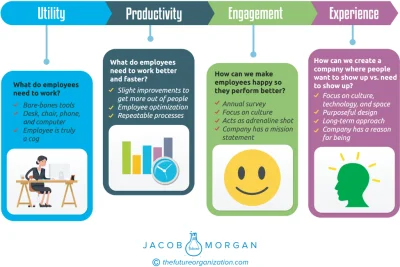
Source: Jacob Morgan
This involves considering factors such as work-life balance, career growth, workplace culture, communication, recognition, and the physical work environment. By actively managing and improving the employee experience, organizations aim to attract and retain top talent, boost employee morale, and ultimately drive better business outcomes.
Significance of Employee Experience Management for Businesses
"Companies that invest in employee experience are 4x more profitable than those that do not."
Valuable employees are a significant investment and can be challenging to come by. Once you've successfully attracted and recruited high-quality individuals, it's essential to retain them. Employee turnover not only consumes your HR team's resources but also affects your business's financial performance.
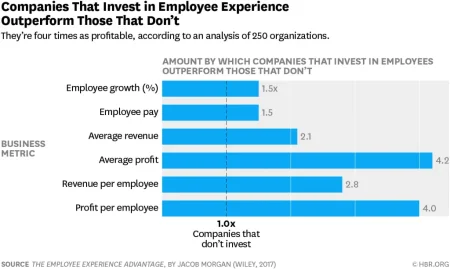
Source: HourOne
Prioritizing a positive employee experience becomes paramount in cultivating an engaged workforce that demonstrates loyalty, ultimately mitigating staff turnover. By investing in the well-being and satisfaction of your employees, you can create an environment where they are motivated to stay, thereby reducing turnover and its associated costs. So, Employee experience management is crucial for businesses for several reasons:
Retention and Engagement A positive employee experience significantly impacts employee retention and engagement. When employees have a fulfilling and rewarding experience at work, they are more likely to stay with the company for the long term. This reduces turnover costs and maintains a stable workforce.
| Productivity and Performance Satisfied employees are more productive and perform at higher levels. When employees feel valued, supported, and motivated, they are more likely to put in extra effort and go above and beyond to achieve their goals. This, in turn, improves overall organizational performance.
|
Talent Attraction A strong employee experience can act as a competitive advantage in attracting top talent. When potential candidates see that a company values its employees and invests in their growth and development, they are more likely to be attracted to the organization. This allows businesses to hire and retain the best talent in the industry.
| Innovation and Creativity Employee experience management encourages a culture of innovation and creativity. When employees feel supported, encouraged to share their ideas, and have the freedom to experiment, they become more willing to contribute innovative solutions and approaches. This drives continuous improvement and keeps the business ahead of the competition.
|
Employee Well-being and Health Prioritizing employee experience includes considering their well-being and health. A positive work environment that promotes work-life balance, provides adequate support systems and encourages employee well-being initiatives (such as wellness programs, flexible working arrangements, and mental health support) can improve employee morale and reduce stress levels. This, in turn, leads to higher job satisfaction, lower absenteeism, and better overall employee health, resulting in a more resilient and productive workforce.
| Employer Branding and Reputation Employee experience directly impacts the employer brand and reputation of a business. In today's competitive job market, potential candidates research a company's reputation as an employer before considering job opportunities. By focusing on employee experience and creating a positive workplace culture, businesses can enhance their employer brand, attracting top talent and becoming an employer of choice. A strong employer brand not only helps with recruitment but also improves the company's overall reputation among clients, partners, and stakeholders.
|
Now that, we understand its importance for business let’s delve deep into its employee experience management strategies.
6 Steps to Implement an Employee Experience Management Strategies
Before delving in, it is important to highlight the three crucial elements that significantly impact an employee's overall experience: company culture, technology, and engagement.
Company culture often revolves around the values upheld by a company and how those values are effectively implemented through policies and procedures. It is essential to explore strategies for fostering a culture that appreciates your IT teams.
Technology plays a significant role in facilitating employee interactions, encompassing various aspects such as communication tools and learning management systems (LMS). Collaborative efforts between HR and IT teams are necessary to optimize technology usage.
Lastly, maintaining high levels of engagement is crucial for ensuring employee motivation and fostering a strong connection between individuals and the organization as a whole.
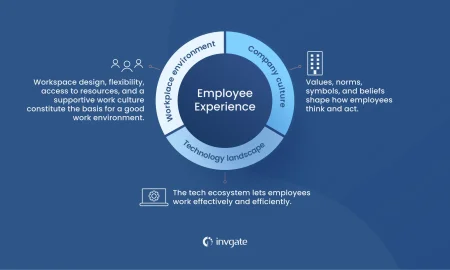
Source: Invgate
Taking into consideration the aforementioned factors, we recommend implementing the following employee experience strategy.
1. Implement People-First Culture in Your Organization
An organizational approach focused on prioritizing people-first culture above their position, seniority, or job title. This strategy aims to cultivate a workplace environment where employees feel valued, respected, and supported. By fostering a culture that provides personalized support, a collaborative and trusting atmosphere can be created, leading to enhanced innovation, productivity, and the development of meaningful relationships. This approach holds particular benefits for IT teams based on our experience.
Implementing a people-first culture serves as the foundational step in establishing a winning strategy. It involves creating a culture of mutual aid and support and ensuring that all employees are aligned with this direction. Regularly communicating the core values of this culture to the workforce is essential. To materialize this approach, consider the following actions:
- Encouraging collaboration
- Recognizing achievements
- Respecting differences
- Creating communications channels and pathways
- Supporting growth
2. Collect Employee Feedback
Gathering employee feedback not only helps identify issues within your employee experience strategy but also reveals areas where your organization has the potential to excel.
Directly seek feedback from employees regarding their overall experience within the company. This can be accomplished through surveys, interviews, focus groups, or other methods of data collection. Many organizations employ an employee experience strategy to conduct regular surveys and obtain actionable insights that inform HR decisions throughout the employee journey.
Keep Your Team Engaged and Motivated
- Send rewards and shortcuts
- Built a sense of purpose
- Hybrid-work friendly rewards
- Showcase your core values
Contact Us
By leveraging effective tools such as Vega HR, managers can gain a deeper understanding of what works best for their organization and implement necessary changes accordingly. To ensure success, two key aspects must be considered:
- Promoting an environment that nurtures open dialogue and collaboration among all team members is an excellent approach to stimulating creativity.
- Avoid solely relying on your expertise and decision-making abilities; instead, distribute the responsibility among team members to achieve the optimal outcome.
3. Adopt Automation
Embracing automation is a crucial aspect of enhancing the employee experience, as it simplifies complex tasks and facilitates the implementation of effective strategies. While improving communication and providing meaningful work are essential, having the right tools is vital for achieving these improvements.
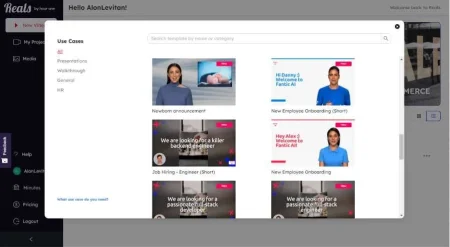
Source: HourOne
One approach to ease the process is automating certain steps of orientation and onboarding procedures. For instance, video calls can be utilized to introduce new employees to existing staff members.
Furthermore, simplifying the allocation of work assignments and partners can be achieved by adopting a learning management system (LMS) or utilizing an employee experience management platform like Vega HR. These platforms streamline the process and enhance efficiency.
4. Promote a Supportive and Collaborative Workspace
By implementing a flexible work environment, employees gain the freedom to work at their preferred time and in their preferred setting. This approach has been proven to enhance productivity, improve overall well-being, job satisfaction, and reduce stress levels, organizational expenses, and absenteeism.
Furthermore, it is crucial for employers to prioritize inclusivity and diversity by observing and assessing how employees interact and collaborate. Recognizing and acknowledging inclusive actions is an important step. Providing education to all managers about unintentional biases and taking proactive measures to mitigate hostile interactions in the workplace is essential.
Lastly, fostering a culture of appreciation is an excellent strategy to uplift employee morale and inspire others to strive for similar achievements. Effective ways to highlight employees' accomplishments include:
- Recognizing and rewarding employees for their achievements.
- Motivating and encouraging employees to contribute blog posts for the company website.
- Promoting and showcasing their accomplishments on the company's social media platforms.
5. Deliver Excellent Communication
Enhancing communication is paramount to fostering stronger connections with employees, similar to any other partnership. Despite the recognition of communication's importance by most HR managers and executives, they often dedicate more time to communicating with the media, stakeholders, and target audience than with their own staff.
To improve communication and collaboration, consider implementing a robust platform such as Vega HR’s employee communication tool. Utilizing employee communication tools enables you to effectively share both positive and negative news, celebrate noteworthy achievements in employees' personal and professional lives, and clearly articulate your company's mission and vision.
6. Offer Growth Opportunities
To foster employee satisfaction and professional advancement, it is essential to offer them compelling work prospects that stimulate their abilities, imbue their roles with significance, and foster their career progression and personal growth. A diverse range of growth opportunities can be provided to your workforce, augmenting their engagement and enriching their tenure within your organization. These opportunities may include:
- Higher-priority tasks
- Increased earnings
- More impressive job titles
- Job-specific training
- Social gatherings outside of work
Final Thoughts
Therefore, by harnessing dedicated platforms for managing employee experience, you can unlock invaluable metrics and insights that will steer you toward enhancing your staff's experiences effectively.
Introducing Vega HR, a robust employee experience management software that empowers you to cultivate remarkable experiences for your workforce. With Vega HR, you can provide your employees with a transparent roadmap, ensuring they have a clear understanding of what awaits them at each stage of their journey within your organization. By leveraging this powerful tool, you can elevate overall employee experience strategy and foster a culture of engagement, satisfaction, and growth.
About Vega HR
Vega-HR is a powerful tool in the talent war, offering employee rewards, recognition, and pulse recognition. With an engaging platform, it fosters a world-class work culture, providing P2P recognition, social feedback, on-spot recognition, and monetizable incentive solutions with 3000+ coupons in various categories.
Create a Culture People Want to Stick to
- Send rewards
- Give shoutouts
- Build a community
- Gift experiences
Get a demo
 Written by Ali Nasir Kidwai 15 June 2023 | 4 min read
Written by Ali Nasir Kidwai 15 June 2023 | 4 min read



